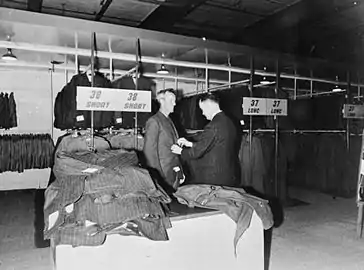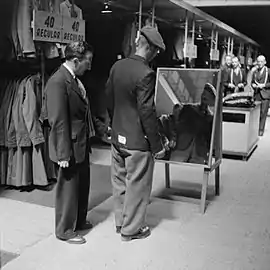
A demob suit was a suit of civilian clothes given to a man on his demobilisation from the British armed forces at the end of the Second World War. Although the suits were of good quality, the need to clothe millions of demobilising servicemen led to supply problems that caused some men to receive suits that were not of the correct size. As a result, the demob suit became a common subject in British comedy in the post-war years.
Etymology
The word "demob", short for demobilisation, came into use in the 1930s.[1] Soldiers had received a set of civilian clothes on demobilisation at the end of the First World War,[2] however, the phrase "demob suit" only came into common use at the end of the Second World War.[3][4][5]
Background
Beginning on 18 June 1945,[6] millions of men were demobilised from the British armed services on a phased basis according to age and length of service.[7] A set of civilian clothes was essential in order to help them integrate into civilian life and because they normally no longer had their original clothes after years in uniform. Clothes rationing meant that it was not possible to buy a new suit from a shop without a large quantity of ration coupons and a long delay while the suit was made.[7]
Many separate demobilisation centres were run by the Army, Royal Navy and Royal Air Force, alongside Civilian Clothing Depots. Army centres were run by the Royal Army Ordnance Corps. One Royal Air Force centre was at Uxbridge.
The suit
At the demobilisation centre, men were issued with their civilian clothes. This was not in exchange for their service uniform which they were allowed to retain. The demob suit was just one part of a complete set of clothes. According to the Imperial War Museum, the full outfit included:[10]
- A felt hat or optional flat cap
- A double-breasted pinstripe three-piece suit, or a single-breasted jacket with flannel trousers
- Two shirts and collars with matching collar studs
- A tie
- Shoes
- A raincoat
A variety of other items are sometimes said to have been supplied, the list varying according to the source, including gloves, underwear, socks, and bowler hats.[11] In addition, men were given a special allocation of clothing coupons with which to buy any extra items they might need, a special cigarette ration, and a one-way rail warrant. Men could keep their service uniform and many left the distribution centres in uniform with a small suitcase containing their demob clothes. Towards the end of 1945, around 75,000 demob suits were being made each week.[7] One of the principal suppliers was Burtons, founded by Montague Burton,[12] leading to speculation that the phrase the full monty, meaning "everything" or "a complete set", originated in reference to a full set of demob clothes supplied by the firm.[13][14] Other manufacturers included the Fifty Shilling Tailors and Simpsons of Piccadilly.[7]
Demob suits were made of the best quality material available in quantity at the time and were not utility clothes.[7] However, problems with distribution meant that the right sizes were not always in stock when the clothes were fitted and the style of what was available was not always what men wanted. These problems made the demob suit the subject of much ridicule and humour. One soldier described his trousers as "unfriendly", saying "they kept their distance from my feet, in mourning at half mast".[6] Another complained that his suit "looked as hostile and intimidating as the bloke pushing it my way".[15]
Men took pot luck with what was available when their turn came. Sometimes only unusual sizes were available, although being a particularly difficult size could be an advantage as then a bespoke suit was ordered and delivered by mail which might be a better fit than one of the off-the-peg suits.[6] The fact that certain versions were very common and easily recognised made some men feel that they had substituted one uniform for another.[7] One remembered that he "walked proudly into town wearing my light grey pin-striped demob suit, looking around, I recognized all the ex-servicemen – they were all back in uniform – light grey pin-striped suits!".[6] Others were embarrassed to wear the suits. One reported that he rarely wore his to work as "both the pattern and the hue made it difficult to hide its patriotic origins".[16] Nonetheless, the suits were often the first that a man had owned and they remained in use for many years after the end of the war, being brought out whenever formal wear was required, such as at Christenings or weddings.[6]
Black market sales
Clothes rationing meant that there was plenty of demand for the suits and the other items on the black market. Spivs (small time criminals dealing in illicit goods) lurked outside distribution centres and offered men £10 for each set of clothes, which some accepted. Questions were asked in Parliament but the government could do nothing as the clothes belonged to the ex-servicemen as soon as they signed for them.[6]
Gallery
Official British Ministry of Information pictures of the demobilisation clothing depot, Olympia, London:
 Regimental Sergeant Major Stilwell has his measurements taken for his demob suit by a tailor at the army's Demobilisation Clothing Depot at Olympia, London.
Regimental Sergeant Major Stilwell has his measurements taken for his demob suit by a tailor at the army's Demobilisation Clothing Depot at Olympia, London. RSM Stilwell selects a jacket for a suit.
RSM Stilwell selects a jacket for a suit. RSM Stilwell is fitted with his demob suit.
RSM Stilwell is fitted with his demob suit. Private Bill Krepper of the Pioneer Corps is assisted in the selection of his demob suit.
Private Bill Krepper of the Pioneer Corps is assisted in the selection of his demob suit. Mr Bill Krepper, late of the Pioneer Corps, leaves the demobilisation clothing depot at Olympia, London, wearing his demob suit.
Mr Bill Krepper, late of the Pioneer Corps, leaves the demobilisation clothing depot at Olympia, London, wearing his demob suit.
In fiction
J.B. Priestley titled his 1945 novel about three returning servicemen facing the challenges of post-war life, Three Men In New Suits.[17] Anthony Powell, who had a successful military career during the war and may have gone through the process himself, used a scene set in the demob centre at Olympia as the conclusion to his 1968 novel The Military Philosophers, "Rank on rank, as far as the eye could scan, hung flannel trousers and tweed coats, drab mackintoshes and grey suits with a white line running through the material", asking whether the massed ranks of empty coats on their hangers somehow symbolised the dead.[18]
In comedy
The demob suit became a popular subject in British comedy after the Second World War as a topic to which millions of people could relate. There was obvious comic potential in a suit that was either too large or too small. The British physical comedian Norman Wisdom, whose suits were always too tight and who had been demobilised himself in 1946, was described by one critic as "Pagliacci in a demob suit".[19] An obituary of Wisdom spoke of his "ill-fitting, half-mast demob suit".[20] Frankie Howerd, one of a whole generation of British comedians who started their career immediately after demobilisation, performed in a badly fitting demob suit, probably because he had nothing else to wear.[21]
See also
Notes and references
- ↑ Ayto, John. (2006). Movers and Shakers: A Chronology of Words that Shaped Our Age (Revised ed.). Oxford: Oxford University Press. p. 90. ISBN 978-0-19-861452-4.
- ↑ Sigsworth, Eric M. (1990). Montague Burton: The Tailor of Taste. Manchester: Manchester University Press. p. 41. ISBN 978-0-7190-2364-4.
- ↑ "demob suit" Collins Dictionaries. Retrieved 3 January 2015.
- ↑ Cumming, Valerie; C. W. Cunnington; P. E. Cunnington (2010). The Dictionary of Fashion History. Berg. p. 65. ISBN 978-1-84788-533-3.
- ↑ Partridge, Eric.; Victor, Terry.; Dalzell, Tom. (Eds.) (2006). The New Partridge Dictionary of Slang and Unconventional English: Volume I, A-I. Abingdon: Routledge. p. 572. ISBN 978-0-415-25937-8.
- 1 2 3 4 5 6 Turner, Barry; Tony Rennell. (2014). When Daddy Came Home: How War Changed Family Life Forever. Random House. pp. 36–39. ISBN 978-1-4735-0515-5.
- 1 2 3 4 5 6 Jobling, Paul. (2014). Advertising Menswear: Masculinity and Fashion in the British Media since 1945. London: Bloomsbury. p. 24. ISBN 978-1-4725-5811-4.
- ↑ Herriot, James. (1979). All Things Wise and Wonderful. London: Pan Books. p. 581. ISBN 978-1-4472-2428-0.
- ↑ Milton, Keith. (2008). Travels of a Nig Nog. Keith Milton. p. 210. ISBN 978-1-4092-2368-9.
- ↑ Jacket, civilian (Demob suit). Imperial War Museum. Retrieved 31 December 2014.
- ↑ Powell, Vince. (2010). From Rags to Gags: The Memoirs of a Comedy Writer. Andrews UK. p. 48. ISBN 978-1-907792-38-0.
- ↑ Burtons Demob Suit. BBC, 2010. Retrieved 4 January 2014.
- ↑ "The Full Monty" The Phrase Finder. Retrieved 4 January 2014.
- ↑ "monty" Oxford Dictionaries. Retrieved 4 January 2014.
- ↑ Diss, Dave. (2005). Dizzy. Lewes: The Book Guild. p. 376. ISBN 978-1-85776-927-2.
- ↑ Kettenacker, Lothar; Torsten Riotte. (2011). The Legacies of Two World Wars: European Societies in the Twentieth Century. Berghahn Books. p. 240. ISBN 978-0-85745-223-8.
- ↑ Robert L. Caserio; Clement Hawes. (Eds.) (2012). The Cambridge History of the English Novel. Cambridge: Cambridge University Press. p. 1180. ISBN 978-1-316-17510-1.
- ↑ Powell, Anthony. (1991) The Military Philosophers. London: Arrow, pp. 241–242 ISBN 0-09-947248-1
- ↑ Macnab, Geoffrey. (2000). Searching for Stars: Stardom and Screen Acting in British Cinema. London: Cassell. p. 98. ISBN 978-1-4411-8425-2.
- ↑ "Norman Wisdom: Tribute to a Comedy Legend" Archived 2015-01-06 at the Wayback Machine Andrew Collins, Sabotage Times, 5 October 2010. Retrieved 6 January 2015.
- ↑ Carpenter, Humphrey (2004). Spike Milligan: The Biography. London: Hodder & Stoughton. p. 44. ISBN 978-1-4447-1788-4.
External links
- Demob. A 1945 Pathé News film.
- Resettlement Advice Centre. 1946 Ministry of Information film.
